Thoroughly analyzing AP Inter 2nd Year Maths 2A Model Papers and AP Inter 2nd Year Maths 2A Question Paper May 2016 helps students identify their strengths and weaknesses.
AP Inter 2nd Year Maths 2A Question Paper May 2016
Time: 3 Hours
Maximum Marks: 75
Note: This question paper consists of THREE sections A, B, and C.
Section – A
(10 × 2 = 20 Marks)
I. Very Short Answer Type Questions.
- Answer ALL questions.
- Each question carries TWO marks.
Question 1.
Find the complex conjugate of (3 + 4i) (2 – 3i).
Solution:
Let z = (3 + 4i) (2 – 3i)
= 6 – 9i + 8i – 12i2
= 6 – 9i + 8i + 12
= 18 – i
∴ \(\bar{z}\) = 18 + i
∴ The complex conjugate of (3 + 4i) (2 – 3i) is 18 + i.
Question 2.
If Arg \(\bar{z}_1\) and Arg \(\bar{z}_2\) are \(\frac{\pi}{5}\) and \(\frac{\pi}{3}\) respectively, then find (Arg z1 + Arg z2).
Solution:

Question 3.
If A, B, C are angles of a triangle such that x = cos A, y = cos B, z = cos C, then find the value of x.y.z.
Solution:
Given x = cos A, y = cos B, z = cos C
Since A, B, C are angles of a triangle.
∴ A + B + C = 180°
xyz = (cos A) (cos B) (cos C)
= cos (A + B + C)
= cos 180°
= cos 180° + i sin 180°
= -1 + i(0)
= -1
∴ xyz = -1
![]()
Question 4.
Find the nature of the roots of 3x2 + 7x + 2 = 0.
Solution:
Given 3x2 + 7x + 2 = 0
Here a = 3, b = 7, c = 2
b2 – 4ac = 49 – 4(3)(2)
= 49 – 24
= 25
= 52
∴ The roots of the given equation are rational and unequal.
Question 5.
If α, β, 1 are the roots of x3 – 2x2 – 5x + 6 = 0, then find α and β.
Solution:
Given α, β, 1 are the roots of x3 – 2x2 – 5x + 6 = 0
Sum of the roots = \(\frac{-(-2)}{1}\)
⇒ α + β + 1 = 2
⇒ α + β = 1 ………..(1)
Product of the roots = \(\frac{-(6)}{1}\)
⇒ (α)(β)(1) = -6
⇒ αβ = -6
We know (α – β)2 = (α + β)2 – 4αβ
= (1)2 – 4(-6)
= 1 + 24
= 25
⇒ α – β = 5 ………(2)
(1) + (2) ⇒ 2α = 6 ⇒ α = 3
(1) – (2) ⇒ 2β = -4 ⇒ β = -2
∴ α = 3, β = -2
Question 6.
Find the number of ways of arranging the letters of the word INTERMEDIATE.
Solution:
The word INTERMEDIATE contains 12 letters in which there are 2I’s are alike, 2T’s are alike and 3E’s are and the rest are different.
∴ The number of required arrangements = \(\frac{(12) !}{2 ! 2 ! 3 !}\)
Question 7.
Find the number of positive divisors of 1080.
Solution:
1080 = 2 × 540
= 22 × 270
= 23 × 135
= 23 × 3 × 45
= 23 × 32 × 15
= 23 × 33 × 51
∴ The number of positive divisors of 1080 = (3 + 1) (3 + 1) (1 + 1)
= 4 × 4 × 2
= 32
Question 8.
Find the 7th term in the expansion of \(\left(\frac{4}{x^3}+\frac{x^2}{2}\right)^{14}\).
Solution:
General term \(T_{r+1}={ }^n C_r x^{n-r} \cdot a^r\)

Question 9.
Find the mean deviation about the mean for the following data:
3, 6, 10, 4, 9, 10
Solution:
Given ungrouped data 3, 6, 10, 4, 9, 10
Arithmetic mean \(\bar{x}\) = \(\frac{3+6+10+4+9+10}{6}\) = 7
The absolute values of the deviations are
\(\left|x_i-\bar{x}\right|\) = |3 – 7|, |6 – 7|, |10 – 7|, |4 – 7|, |9 – 7|, |10 – 7| = 4, 1, 3, 3, 2, 3
∴ Mean deviation from the mean = \(\frac{\Sigma\left|x_i-\bar{x}\right|}{6}\)
= \(\frac{4+1+3+3+2+3}{6}\)
= \(\frac{16}{6}\)
= 2.66
![]()
Question 10.
A Poisson variable satisfies P(X = 1) = P(X = 2), find P(X = 5).
Solution:
We know P(X = r) = \(\frac{e^{-\lambda} \lambda^r}{r !}\)
Given P(X = 1) = P(X = 2)

Section – B
(5 × 4 = 20 Marks)
II. Short Answer Type Questions.
- Answer ANY FIVE questions.
- Each question carries FOUR marks.
Question 11.
If x + iy = \(\frac{1}{1+\cos \theta+i \sin \theta}\), then show that 4x2 – 1 = 0.
Solution:
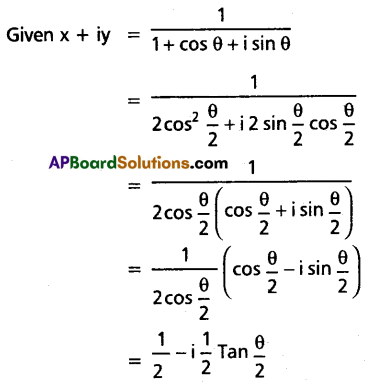
Equating real parts on both sides, we have 1
x = \(\frac{1}{2}\)
⇒ x2 = \(\frac{1}{4}\)
⇒ 4x2 = 1
⇒ 4x2 – 1 = 0
Question 12.
Find the range of \(\frac{x+2}{2 x^2+3 x+6}\).
Solution:
Let y = \(\frac{x+2}{2 x^2+3 x+6}\)
⇒ x + 2 = 2yx2 + 3xy + 6y
⇒ 2yx2 + (3y – 1)x + (6y – 2) = 0
x ∈ R ⇒ (3y – 1)2 – 4(2y)(6y – 2) ≥ 0
⇒ 9y2 – 6y + 1 – 48y2 + 16y ≥ 0
⇒ -39y2 + 10y + 1 ≥ 0
⇒ 39y2 – 10y – 1 ≤ 0
⇒ 39y2 – 13y + 3y – 1 ≤ 0
⇒ 13y(3y – 1) + 1(3y – 1) ≤ 0
⇒ (13y + 1) (3y – 1) ≤ 0
⇒ y ∈ \(\left[\frac{-1}{13}, \frac{1}{3}\right]\)
∴ Range of \(\frac{x+2}{2 x^2+3 x+6}\) is \(\left[\frac{-1}{13}, \frac{1}{3}\right]\)
Question 13.
If the letters of the word EAMCET are permuted in all possible ways and if the words thus formed are arranged in the dictionary order, then find the rank of the word EAMCET.
Solution:
The dictionary order of the letters of the word EAMCET is A, C, E, E, M, T
In dictionary order the words which begin with the letter A come from first.
If we fill the first place with A remaining 5 letters can be arranged in \(\frac{5 !}{2 !}\) ways.
A – – – – – = \(\frac{5 !}{2 !}=\frac{120}{2}\) = 60
C – – – – – = \(\frac{5 !}{2 !}=\frac{120}{2}\) = 60
E A C – – – = 3! = 6
E A E – – – = 3! = 6
The next word is EAMCET = 1
Hence the rank of the word EAMCET = 60 + 60 + 6 + 6 + 1 = 133
Question 14.
Find the number of ways of selecting a cricket team of 11 players from 7 batsmen and 6 bowlers such that there will be at least 5 bowlers in the team.
Solution:
Since the team consists of atleast 5 bowlers, the selection may be of the following types.
| Batsmen (7) | Bowlers (6) | |
| Type 1 | 6 | 5 |
| Type 2 | 5 | 6 |
The no. of selections is first type = 7C6 × 6C5 = 7 × 6 = 42
The no. of selections in second type = 7C5 × 6C6 = 21 × 1 = 21
∴ The required number of ways of selecting the cricket team = 42 + 21 = 63
![]()
Question 15.
Resolve \(\frac{x^2-3}{(x+2)\left(x^2+1\right)}\) into partial fractions.
Solution:
Let \(\frac{x^2-3}{(x+2)\left(x^2+1\right)}=\frac{A}{x+2}+\frac{B x+C}{x^2+1}\)
⇒ \(\frac{x^2-3}{(x+2)\left(x^2+1\right)}=\frac{A\left(x^2+1\right)+(B x+C)(x+2)}{(x+2)\left(x^2+1\right)}\)
⇒ x2 – 3 = A(x2 + 1) + (Bx + C) (x + 2) ………(1)
Put x = -2 in (1)
(-2)2 – 3 = A[(-2)2 + 1]
⇒ 4 – 3 = A(4 + 1)
⇒ 1 = 5A
⇒ A = \(\frac{1}{5}\)
Comparing the coefficients of x2 and constant terms in (1), we get
1 = A + B
⇒ 1 = \(\frac{1}{5}\) + B
⇒ B = 1 – \(\frac{1}{5}\)
⇒ B = \(\frac{4}{5}\)
3 = A + 2C
⇒ 2C = -3 – A
⇒ 2C = -3 – \(\frac{1}{5}\)
⇒ 2C = \(\frac{-16}{5}\)
⇒ C = \(\frac{-8}{5}\)
∴ \(\frac{x^2-3}{(x+2)\left(x^2+1\right)}=\frac{\frac{1}{5}}{x+2}+\frac{\frac{4}{5} x-\frac{8}{5}}{x^2+1}\) = \(\frac{1}{5(x+2)}+\frac{4 x-8}{5\left(x^2+1\right)}\)
Question 16.
If A, B, and C are three events, show that P(A ∪ B ∪ C) = P(A) + P(B) + P(C) – P(A ∩ B) – P(B ∩ C)
– P(C ∩ A) + P(A ∩ B ∩ C).
Solution:
P(A ∪ B ∪ C) = P(A) + P(B ∪ C) – P[(A ∩ B ∪ C)]
= P(A) + P(B) + P(C) – P(B ∩ C) – P[(A ∩ B) ∪ (A ∩ C)]
= P(A) + P(B) + P(C) – P(B ∩ C) – [P(A ∩ B) + P(A ∩ C) – P{(A ∩ B) ∩ (A ∩ C)}]
= P(A) + P(B) + P(C) – P(B ∩ C) – P(A ∩ B) – P(A ∩ C) + P(A ∩ B ∩ C)
∴ P(A ∪ B ∪ C) = P(A) + P(B) + P(C) – P(A ∩ B) – P(B ∩ C) – P(C ∩ A) + P(A ∩ B ∩ C)
Question 17.
If A, B, C are three independent events of an experiment, such that P(A ∩ BC ∩ CC) = \(\frac{1}{4}\), P(AC ∩ B ∩ CC) = \(\frac{1}{8}\), P(AC ∩ BC ∩ CC) = \(\frac{1}{4}\), then find P(A), P(B), P(C).
Solution:
Since A, B, and C are independent events.
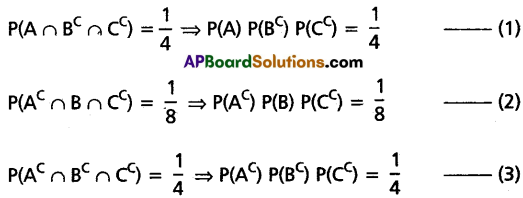


Section – C
(5 × 7 = 35 Marks)
III. Long Answer Type Questions.
- Answer ANY FIVE questions.
- Each question carries SEVEN marks.
Question 18.
If cos α + cos β + cos γ = 0 = sin α + sin β + sin γ, then prove that cos2α + cos2β + cos2γ = \(\frac{3}{2}\)
Solution:
Let a = cos α + i sin α
b = cos β + i sin β
c = cos γ + i sin γ
a + b + c = (cos α + i sin α) + (cos β + i sin β) + (cos γ + i sin γ)
= (cos α + cos β + cos γ) + i(sin α + sin β + sin γ)
= 0 + i(0)
= 0
⇒ a + b + c = 0
\(\frac{1}{a}+\frac{1}{b}+\frac{1}{c}=\frac{1}{\cos \alpha+i \sin \alpha}+\frac{1}{\cos \beta+i \sin \beta}+\frac{1}{\cos \gamma+i \sin \gamma}\)
\(\frac{b c+c a+a b}{a b c}\) = cos α – i sin α + cos β – i sin β + cos γ – i sin γ
= (cos α + cos β + cos γ) + i(sin α + sin β + sin γ)
= 0 – i(0)
= 0
⇒ ab + bc + ca = 0
∴ (a + b + c)2 = a2 + b2 + c2 + 2(ab + bc + ca)
⇒ 0 = a2 + b2 + c2 + 2(0)
⇒ a2 + b2 + c2 = 0
⇒ (cos α + i sin α)2 + (cos β + i sin β)2 + (cos γ + i sin γ)2 = 0
⇒ cos 2α + i sin 2α + cos 2β + i sin 2β + cos 2γ + i sin 2γ = 0
⇒ (cos 2α + cos 2β + cos 2γ) + i(sin 2α + sin 2β + sin 2γ) = 0
Equation real parts on both sides, we have
cos 2α + cos 2β + cos 2γ = 0
⇒ 1 – 2 sin2α + 1 – 2 sin2β + 1 – 2 sin2γ = 0
⇒ 3 = 2(sin2α + sin2β + sin2γ)
⇒ sin2α + sin2β + sin2γ = \(\frac{3}{2}\)
Again cos 2α + cos 2β + cos 2γ = 0
⇒ 2 cos2α – 1 + 2 cos2β – 1 + 2 cos2γ – 1 = 0
⇒ 2(cos2α + cos2β + cos2γ) = 3
⇒ cos2α + cos2β + cos2γ = \(\frac{3}{2}\)
∴ cos2α + cos2β + cos2γ = \(\frac{3}{2}\) = sin2α + sin2β + sin2γ
![]()
Question 19.
Solve the following equation x5 – 5x4 + 9x3 – 9x2 + 5x – 1 = 0.
Solution:
Given x5 – 5x4 + 9x3 – 9x2 + 5x – 1 = 0
We observe that the given equation is an odd-degree reciprocal equation of class two.
∴ 1 is a root of the given equation

∴ (x – 1) (x4 – 4x3 + 5x2 – 4x + 1) = 0
⇒ x – 1 = 0, x4 – 4x3 + 5x2 – 4x + 1 = 0
⇒ x = 1, x2 – 4x + 5 – \(\frac{4}{x}+\frac{1}{x^2}\) = 0 [∵ on dividing by x2]
⇒ \(\left(x^2+\frac{1}{x^2}\right)-4\left(x+\frac{1}{x}\right)\) + 5 = 0
Put x + \(\frac{1}{x}\) = y Then x2 + \(\frac{1}{x^2}\) = y2 – 2
∴ y2 – 2 – 4y + 5 = 0
⇒ y2 – 4y + 3 = 0
⇒ y2 – y – 3y + 3 = 0
⇒ y(y – 1) – 3(y – 1) = 0
⇒ (y – 1) (y – 3) = o
⇒ y = 1 (or) y = 3
∴ y = 1
x + \(\frac{1}{x}\) = 1
⇒ x2 + 1 = x
⇒ x2 – x + 1 = 0
⇒ x = \(\frac{1 \pm \sqrt{1-4(1)(1)}}{2(1)}\)
⇒ x = \(\frac{1 \pm \sqrt{-3}}{2}\)
⇒ x = \(\frac{1 \pm i \sqrt{3}}{2}\)
∴ y = 3
⇒ x + \(\frac{1}{x}\) = 3
⇒ x2 + 1 = 3x
⇒ x2 – 3x + 1 = 0
⇒ x = \(\frac{3 \pm \sqrt{9-4.1 .1}}{2}\)
⇒ x = \(\frac{3 \pm \sqrt{5}}{2}\)
∴ The roots of the given equation are 1, \(\frac{1 \pm i \sqrt{3}}{2}\), \(\frac{3 \pm \sqrt{5}}{2}\).
Question 20.
If n is a positive integer and x is any non-zero real number, then prove that
\(C_0+C_1 \cdot \frac{x}{2}+C_2 \cdot \frac{x^2}{3}+C_3 \cdot \frac{x^3}{4}+\ldots .+C_n \frac{x^n}{n+1}=\frac{(1+x)^{n+1}-1}{(n+1) x}\)
Solution:
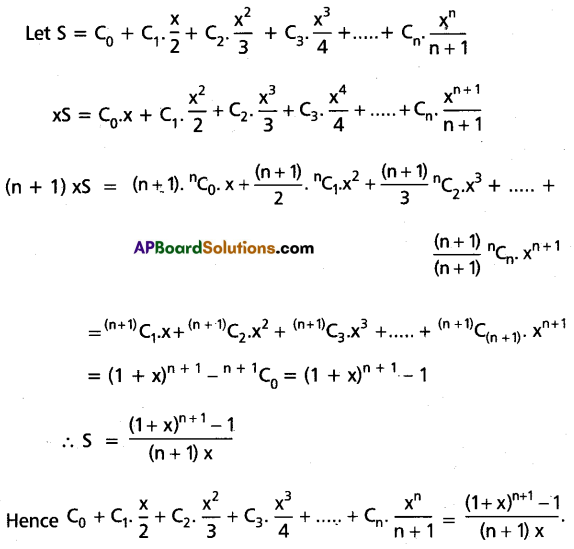
Question 21.
If x = \(\frac{1.3}{3.6}+\frac{1.3 .5}{3.6 .9}+\frac{1 \cdot 3.5 .7}{3 \cdot 6 \cdot 9.12}\) + …….., then prove that 9x2 + 24x = 11.
Solution:



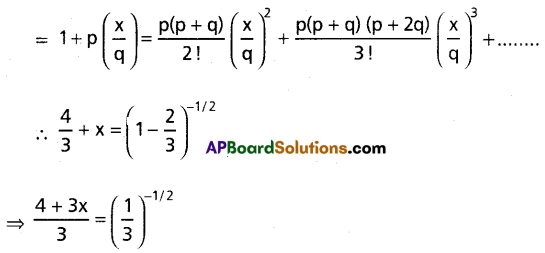
⇒ 4 + 3x = 3√3
⇒ (4 + 3x)2 = 27
⇒ 16 + 9x2 + 24x = 27
⇒ 9x2 + 24x = 11
![]()
Question 22.
Calculate the variance and standard deviation of the following continuous frequency distribution.
| Class Interval | Frequency |
| 30-40 | 3 |
| 40-50 | 7 |
| 50-60 | 12 |
| 60-70 | 15 |
| 70-80 | 8 |
| 80-90 | 3 |
| 90-100 | 2 |
Solution:
Here h = 10 and take assumed mean A = 65
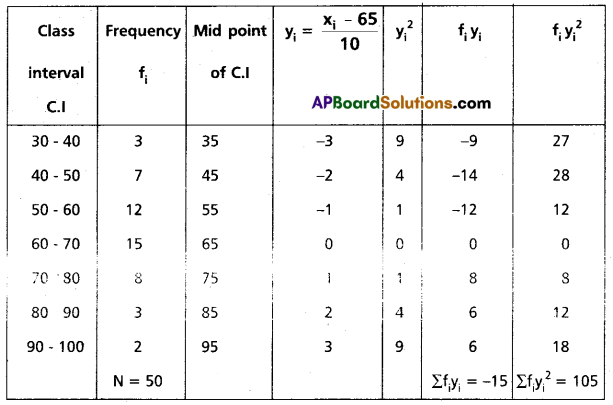


Standard deviation σ = √201 = 14.18
Question 23.
State and Prove Baye’s theorem.
Solution:
Statement: Let E1, E2, ………, En are mutually exclusive and exhaustive events or a random experiment with P(Ei) ≠ 0 for i = 1, 2, 3,……….n.
Then for any event A or the random experiment with P(A) ≠ 0

Proof: Given that P(Ei) > 0 for i = 1, 2,……n
By hypothesis i ≠ j, Ei ∩ Kj = φ, and E1 ∪ E2 ∪ ……. ∪ En = S
A = A ∩ S
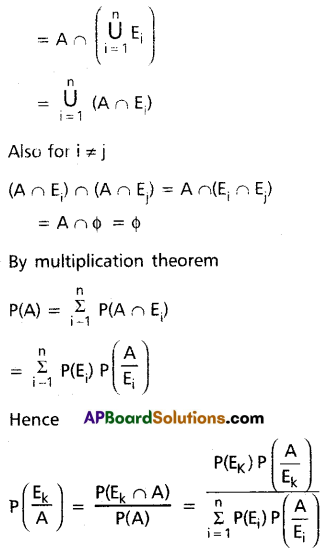
![]()
Question 24.
A random variable X has the following probability distribution:
| X = x | P(X = x) |
| 0 | 0 |
| 1 | k |
| 2 | 2k |
| 3 | 2k |
| 4 | 3k |
| 5 | k2 |
| 6 | 2k2 |
| 7 | 7k2 + k |
Find (i) k (ii) the mean and (iii) P(0 < X < 5).
Solution:
We know P(X = x) = 1
⇒ P(X = 0) + P(X = 1) + P(X = 2) + P(X = 3) + P(X = 4) + P(X = 5) + P(X = 6) + P(X = 7) = 1
⇒ 0 + k + 2k + 2k + 3k + k2 + 2k2 + 7k2 + k = 1
⇒ 10k2 + 9k = 1
⇒ 10k2 + 9k – 1 = 0
⇒ 10k2 + 10k – k – 1 = 0
⇒ 10k(k + 1) – 1(k + 1) = 0
⇒ (k + 1) (10k – 1) = 0
⇒ k = -1 (or) \(\frac{1}{10}\)
(i) k = \(\frac{1}{10}\) Since k > 0
(ii) Mean = 0 (P = 0) + 1 P(X = 1) + 2 P(X = 2) + 3 P(X = 3) + 4 P(X = 4) + 5 P(X = 5) + 6 P(X = 6) + 7 P(X = 7)
= 0(0) + 1(k) + 2(2k) + 3(2k) + 4(3k) + 5(k2) + 6(2k2) + 7(7k2 + k)
= 0 + k + 4k + 6k + 12k + 5k2 + 12k2 + 49k2 + 7k
= 66k2 + 30k
= 66(\(\frac{1}{1o0}\)) + 30(\(\frac{1}{10}\))
= 0.66 + 3
= 3.66
(iii) P(0 < x < 5) = P(X = 1) + P(X = 2) + P(X = 3) + P(X = 4)
= k + 2k + 2k + 3k
= 8k
= 8(\(\frac{1}{10}\))
= 0.8
∴P(0 < x < 5) = 0.8